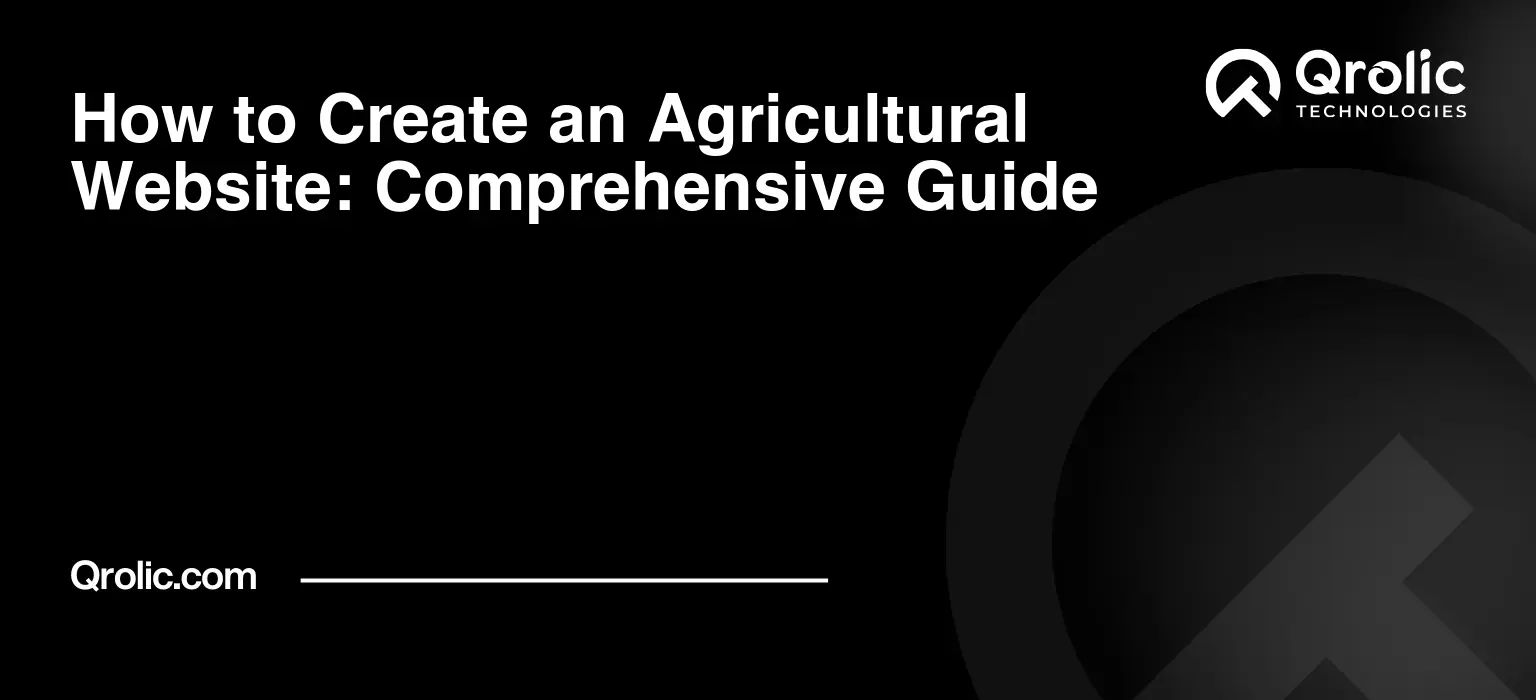Quick Summary:
- An agricultural website grows reach and builds trust.
- Plan goals, audience, domain, hosting, and content.
- Choose tools, design for mobile, and add key features.
- Promote, optimize for search, and maintain regularly.
Table of Contents
- Why Your Farm Needs a Website: Planting the Seeds for Online Success
- Reaching a Wider Customer Base: Harvesting New Opportunities
- Building Trust and Credibility: Cultivating Customer Confidence
- Enhancing Customer Service: Nurturing Relationships
- Showcasing Your Products and Services: A Digital Harvest
- Cost-Effectiveness: Investing in Your Future
- Planning Your Agricultural Website: Laying the Foundation for Success
- Defining Your Goals: Setting a Course for Success
- Identifying Your Target Audience: Knowing Your Customer
- Choosing a Domain Name: Claiming Your Online Territory
- Selecting a Web Hosting Provider: Providing a Home for Your Website
- Planning Your Website Content: Sowing the Seeds of Engagement
- Choosing a Website Builder: Selecting the Right Tools for the Job
- Content Management Systems (CMS): Empowering Your Content
- Website Builders: Drag-and-Drop Simplicity
- E-Commerce Platforms: Selling Your Harvest Online
- Designing Your Agricultural Website: Creating a Visually Appealing and User-Friendly Experience
- Choosing a Theme or Template: Setting the Visual Tone
- Using High-Quality Images and Videos: Showcasing Your Farm’s Beauty
- Optimizing for Mobile Devices: Reaching Customers on the Go
- Creating a User-Friendly Navigation: Guiding Visitors Through Your Website
- Ensuring Accessibility: Reaching Everyone
- Adding Essential Features: Enhancing Functionality and User Experience
- E-Commerce Functionality: Selling Your Products Online
- Contact Forms: Making it Easy to Connect
- Social Media Integration: Expanding Your Reach
- Blog Integration: Sharing Your Expertise
- Newsletter Signup: Building Your Email List
- Optimizing for Search Engines (SEO): Attracting Organic Traffic
- Keyword Research: Identifying the Right Terms
- On-Page Optimization: Making Your Website Search-Engine Friendly
- Off-Page Optimization: Building Your Website’s Authority
- Monitoring and Analyzing Your Results: Tracking Your Progress
- Promoting Your Agricultural Website: Spreading the Word
- Social Media Marketing: Engaging Your Audience
- Email Marketing: Nurturing Your Leads
- Online Advertising: Reaching a Targeted Audience
- Public Relations: Building Your Brand Reputation
- Content Marketing: Providing Value and Attracting Visitors
- Maintaining and Updating Your Website: Ensuring Long-Term Success
- Regularly Updating Content: Keeping Things Fresh
- Monitoring Website Performance: Identifying and Addressing Issues
- Backing Up Your Website: Protecting Your Data
- Staying Up-to-Date with Technology: Adapting to Change
- Qrolic Technologies: Your Partner in Agricultural Website Success
- Web Design and Development: Creating a Custom Solution
- Digital Marketing: Reaching Your Target Audience
- Ongoing Support and Maintenance: Ensuring Long-Term Success
- Conclusion: Cultivating Your Online Presence for a Bountiful Future
Why Your Farm Needs a Website: Planting the Seeds for Online Success
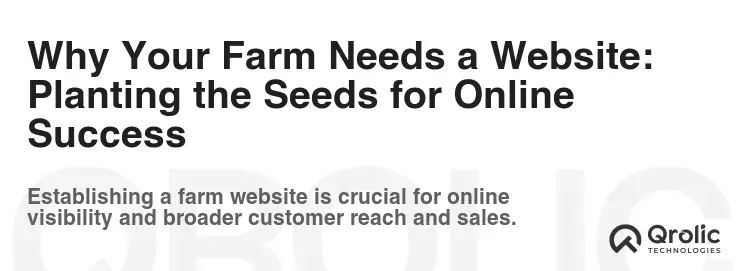
In today’s digital age, having an online presence is no longer a luxury; it’s a necessity. This holds true for the agricultural sector as much as any other. Think of your website as your digital storefront, open 24/7, showcasing your farm, your products, and your story to a global audience. But why is this so critical?
Reaching a Wider Customer Base: Harvesting New Opportunities
Traditionally, farms relied on local markets and word-of-mouth. While these are still important, a website allows you to break free from geographical limitations. Imagine selling your organic produce not just to your local community, but to customers across the state, or even the country.
- Extending Your Reach: A website acts as a virtual farm stand, open to anyone with an internet connection.
- Attracting New Customers: Online marketing and search engine optimization (SEO) can help you reach customers actively searching for agricultural products and services.
- Diversifying Your Market: Online sales can supplement your existing revenue streams, providing a more stable and sustainable business model.
Building Trust and Credibility: Cultivating Customer Confidence
In an industry often steeped in tradition, demonstrating innovation and transparency can set you apart. A well-designed website allows you to showcase your farming practices, highlight the quality of your products, and build trust with potential customers.
- Sharing Your Story: Tell the story of your farm, your family, and your values. Customers connect with authenticity.
- Demonstrating Transparency: Showcase your sustainable farming practices, certifications, and quality control measures.
- Providing Information: Answer frequently asked questions, offer product details, and provide educational content related to agriculture.
Enhancing Customer Service: Nurturing Relationships
A website isn’t just a static brochure; it’s a dynamic communication tool. You can use it to provide excellent customer service, answer inquiries promptly, and build lasting relationships.
- Providing Contact Information: Make it easy for customers to reach you via phone, email, or contact form.
- Answering FAQs: Create a comprehensive FAQ section to address common questions.
- Offering Online Ordering: Simplify the purchasing process with an easy-to-use online store.
- Gathering Feedback: Use surveys and feedback forms to understand customer needs and improve your services.
Showcasing Your Products and Services: A Digital Harvest
Your website is the perfect place to display the fruits (and vegetables!) of your labor. High-quality photos, detailed descriptions, and customer testimonials can entice visitors and drive sales.
- Visual Appeal: Use professional photography to showcase your products in their best light.
- Detailed Descriptions: Provide accurate and informative descriptions of your products, including ingredients, sizes, and prices.
- Customer Reviews: Feature positive reviews and testimonials to build credibility and encourage purchases.
- Seasonal Offerings: Highlight seasonal products and special promotions to keep your website fresh and engaging.
Cost-Effectiveness: Investing in Your Future
While there is an initial investment involved in creating a website, it can be a cost-effective marketing solution in the long run. Compared to traditional advertising methods, a website offers a high return on investment by reaching a wider audience and generating leads consistently.
- Reduced Marketing Costs: A website can serve as your primary marketing tool, reducing the need for expensive print advertising or radio spots.
- Increased Sales: A well-designed website can drive online sales and attract new customers, boosting your revenue.
- Improved Efficiency: Online ordering and customer service can streamline your operations and free up your time.
Planning Your Agricultural Website: Laying the Foundation for Success

Before diving into the technical aspects of creating your website, it’s essential to have a clear plan. This involves defining your goals, identifying your target audience, and outlining the content you want to include.
Defining Your Goals: Setting a Course for Success
What do you want to achieve with your website? Are you looking to increase sales, build brand awareness, or educate consumers about sustainable agriculture? Clearly defined goals will guide your website’s design and content.
- Increase Online Sales: If your primary goal is to sell products online, your website should focus on e-commerce features and product presentation.
- Generate Leads: If you’re looking to attract new customers, your website should include lead capture forms and compelling calls to action.
- Build Brand Awareness: If you want to establish your farm as a trusted source of information, your website should focus on educational content and storytelling.
- Improve Customer Service: If you want to enhance customer satisfaction, your website should provide helpful resources and easy access to support.
Identifying Your Target Audience: Knowing Your Customer
Who are you trying to reach with your website? Farmers, consumers, retailers, or distributors? Understanding your target audience will help you tailor your website’s design, content, and messaging.
- Farmers: If you’re targeting other farmers, your website should focus on providing technical information, industry news, and networking opportunities.
- Consumers: If you’re targeting consumers, your website should focus on showcasing your products, highlighting their benefits, and building trust.
- Retailers: If you’re targeting retailers, your website should focus on providing wholesale pricing, product information, and ordering details.
- Distributors: If you’re targeting distributors, your website should focus on providing logistical information, product availability, and pricing.
Choosing a Domain Name: Claiming Your Online Territory
Your domain name is your website’s address on the internet. It should be memorable, relevant to your farm, and easy to spell.
- Relevance: Choose a domain name that reflects your farm’s name or the products you sell.
- Memorability: Keep it short, simple, and easy to remember.
- Availability: Check if the domain name is available before you commit to it.
- Extension: Opt for a common extension like .com, .net, or .org. Consider a country-specific extension if you primarily serve a local market (e.g., .ca for Canada).
Selecting a Web Hosting Provider: Providing a Home for Your Website
Web hosting is a service that provides the server space and resources needed to host your website online. Choose a reliable hosting provider that offers adequate storage, bandwidth, and security.
- Storage: Ensure the hosting plan provides enough storage space for your website’s files, images, and videos.
- Bandwidth: Choose a plan that offers sufficient bandwidth to handle your website’s traffic.
- Uptime: Look for a hosting provider that guarantees high uptime (at least 99.9%).
- Security: Ensure the hosting provider offers security features like SSL certificates and regular backups.
- Customer Support: Choose a provider with responsive and helpful customer support.
Planning Your Website Content: Sowing the Seeds of Engagement
Your website’s content is what will attract visitors and keep them coming back. Plan your content carefully, ensuring it’s informative, engaging, and relevant to your target audience.
- Homepage: Your homepage is your website’s welcome mat. It should provide a brief overview of your farm, highlight your key products or services, and guide visitors to other parts of your website.
- About Us: Tell the story of your farm, your family, and your values. This is an opportunity to connect with visitors on a personal level and build trust.
- Products/Services: Showcase your products or services with high-quality photos, detailed descriptions, and pricing information.
- Blog: Share informative articles, recipes, farm updates, and industry news. A blog can help you attract visitors through search engines and establish your farm as a trusted source of information.
- Contact Us: Provide clear and easy-to-find contact information, including your phone number, email address, and physical address.
- FAQ: Answer frequently asked questions to address common concerns and provide helpful information.
- Testimonials: Feature positive reviews and testimonials from satisfied customers to build credibility and encourage purchases.
- Gallery: Showcase your farm’s beauty with a photo gallery or video tour.
Choosing a Website Builder: Selecting the Right Tools for the Job
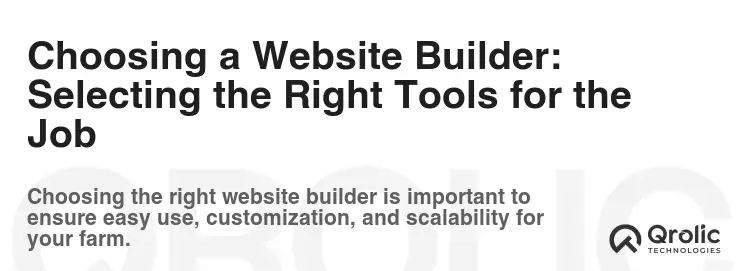
Once you have a plan in place, you’ll need to choose a website builder. There are several options available, each with its own strengths and weaknesses.
Content Management Systems (CMS): Empowering Your Content
A CMS is a software application that allows you to create, manage, and publish content on your website without requiring coding knowledge. Popular CMS platforms include WordPress, Joomla, and Drupal.
- wordpress: The most popular CMS in the world, WordPress offers a vast library of themes and plugins, making it highly customizable and user-friendly.
- Joomla: A powerful and flexible CMS, Joomla is suitable for complex websites with advanced features.
- Drupal: A highly customizable CMS, Drupal is often used for government and enterprise websites.
Website Builders: Drag-and-Drop Simplicity
Website builders are user-friendly platforms that allow you to create a website using a drag-and-drop interface. Popular website builders include Wix, Squarespace, and Weebly.
- Wix: A popular website builder with a wide range of templates and features, Wix is suitable for small businesses and individuals.
- Squarespace: A stylish and user-friendly website builder, Squarespace is known for its elegant designs and ease of use.
- Weebly: A simple and affordable website builder, Weebly is a good option for beginners.
E-Commerce Platforms: Selling Your Harvest Online
If you plan to sell products online, you’ll need an e-commerce platform. Popular e-commerce platforms include Shopify, WooCommerce, and BigCommerce.
- Shopify: A leading e-commerce platform, Shopify offers a comprehensive suite of features for selling products online, including inventory management, payment processing, and shipping integrations.
- WooCommerce: A popular e-commerce plugin for WordPress, WooCommerce allows you to turn your WordPress website into an online store.
- BigCommerce: A scalable e-commerce platform, BigCommerce is suitable for larger businesses with complex needs.
Designing Your Agricultural Website: Creating a Visually Appealing and User-Friendly Experience

Your website’s design is crucial for attracting visitors and keeping them engaged. A well-designed website should be visually appealing, user-friendly, and mobile-responsive.
Choosing a Theme or Template: Setting the Visual Tone
A theme or template is a pre-designed layout for your website. Choose a theme or template that is visually appealing, relevant to your farm, and mobile-responsive.
- Relevance: Choose a theme or template that reflects the style and values of your farm.
- Responsiveness: Ensure the theme or template is mobile-responsive, meaning it will adapt to different screen sizes.
- Customization: Choose a theme or template that allows for customization, so you can tailor it to your specific needs.
- Reviews and Ratings: Check the reviews and ratings of the theme or template before you commit to it.
Using High-Quality Images and Videos: Showcasing Your Farm’s Beauty
Visual content is essential for engaging visitors and showcasing your farm’s beauty. Use high-quality images and videos to highlight your products, your farming practices, and your overall brand.
- Professional Photography: Hire a professional photographer to capture stunning images of your farm and your products.
- Video Tours: Create a video tour of your farm to give visitors a virtual glimpse into your operations.
- Product Photography: Use professional product photography to showcase your products in their best light.
- Image Optimization: Optimize your images for the web to ensure they load quickly and don’t slow down your website.
Optimizing for Mobile Devices: Reaching Customers on the Go
More and more people are accessing the internet on their mobile devices. Ensure your website is mobile-responsive, meaning it will adapt to different screen sizes.
- Responsive Design: Choose a responsive theme or template that automatically adjusts to different screen sizes.
- Mobile-Friendly Navigation: Ensure your website’s navigation is easy to use on mobile devices.
- Fast Loading Times: Optimize your website for speed to ensure it loads quickly on mobile devices.
- Touch-Friendly Elements: Use touch-friendly elements like large buttons and clear calls to action.
Creating a User-Friendly Navigation: Guiding Visitors Through Your Website
Your website’s navigation should be clear, intuitive, and easy to use. Visitors should be able to find the information they’re looking for quickly and easily.
- Simple Menu Structure: Use a simple and logical menu structure to organize your website’s content.
- Clear Labels: Use clear and descriptive labels for your menu items.
- Search Functionality: Include a search function so visitors can easily find specific information.
- Breadcrumb Navigation: Use breadcrumb navigation to show visitors where they are on your website.
Ensuring Accessibility: Reaching Everyone
Make sure your website is accessible to people with disabilities. This includes providing alternative text for images, using sufficient color contrast, and ensuring your website is navigable using a keyboard.
- Alternative Text for Images: Provide alternative text for all images so screen readers can describe them to visually impaired users.
- Sufficient Color Contrast: Use sufficient color contrast between text and background to ensure readability for people with visual impairments.
- Keyboard Navigation: Ensure your website is navigable using a keyboard for people who cannot use a mouse.
- Clear and Concise Language: Use clear and concise language to make your website easy to understand for everyone.
Adding Essential Features: Enhancing Functionality and User Experience
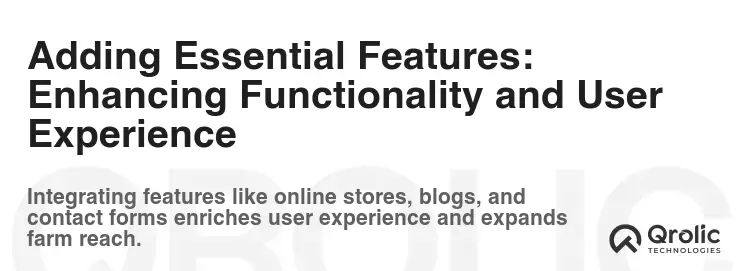
Beyond the basic design, several features can enhance your website’s functionality and user experience.
E-Commerce Functionality: Selling Your Products Online
If you plan to sell products online, you’ll need to integrate e-commerce functionality into your website. This includes features like product catalogs, shopping carts, and payment processing.
- Product Catalogs: Create a visually appealing and easy-to-navigate product catalog.
- Shopping Carts: Implement a secure and user-friendly shopping cart.
- Payment Processing: Integrate with a reliable payment gateway to accept online payments.
- Shipping Options: Offer a variety of shipping options to meet your customers’ needs.
- Order Tracking: Provide order tracking information so customers can monitor the status of their orders.
Contact Forms: Making it Easy to Connect
A contact form allows visitors to easily reach you with inquiries or feedback. Make sure your contact form is easy to find and use.
- Required Fields: Include only the necessary fields in your contact form to minimize friction.
- Captcha: Use a captcha to prevent spam submissions.
- Thank You Message: Display a thank you message after the form is submitted to confirm receipt.
- Email Notifications: Configure email notifications so you’re alerted when a new form submission is received.
Social Media Integration: Expanding Your Reach
Integrate your website with your social media accounts to expand your reach and engage with your audience.
- Social Media Buttons: Add social media buttons to your website to make it easy for visitors to share your content.
- Social Media Feed: Display a social media feed on your website to showcase your latest posts.
- Social Sharing: Encourage visitors to share your content on social media by adding social sharing buttons to your blog posts and product pages.
Blog Integration: Sharing Your Expertise
A blog is a great way to share your expertise, attract visitors through search engines, and establish your farm as a trusted source of information.
- Regular Updates: Post regularly to keep your blog fresh and engaging.
- High-Quality Content: Create informative and engaging content that is relevant to your target audience.
- SEO Optimization: Optimize your blog posts for search engines to attract more traffic.
- Comments Section: Encourage comments and discussions to foster a sense of community.
Newsletter Signup: Building Your Email List
A newsletter signup form allows you to collect email addresses and build your email list. This is a valuable marketing tool for promoting your products, announcing events, and sharing news.
- Clear Value Proposition: Explain the benefits of subscribing to your newsletter.
- Double Opt-In: Use a double opt-in process to ensure subscribers are genuinely interested in receiving your emails.
- Segmentation: Segment your email list based on subscriber interests to send targeted messages.
- Privacy Policy: Link to your privacy policy to assure subscribers that their information will be kept confidential.
Optimizing for Search Engines (SEO): Attracting Organic Traffic
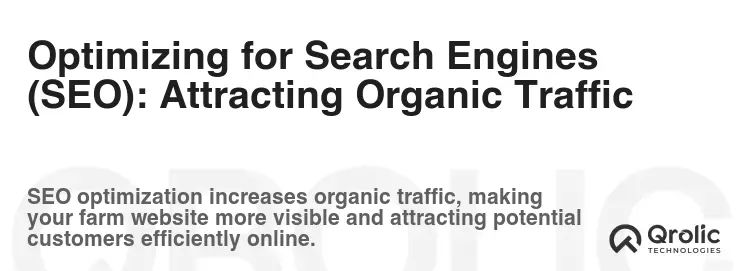
Search engine optimization (SEO) is the process of optimizing your website to rank higher in search engine results pages (SERPs). This can help you attract more organic traffic to your website.
Keyword Research: Identifying the Right Terms
Keyword research involves identifying the terms that your target audience is using to search for agricultural products and services. Use keyword research tools like Google Keyword Planner and SEMrush to find relevant keywords.
- Relevance: Choose keywords that are relevant to your farm and your products.
- Search Volume: Target keywords with a decent search volume.
- Competition: Consider the competition for each keyword.
- Long-Tail Keywords: Focus on long-tail keywords (longer, more specific phrases) to attract highly targeted traffic.
On-Page Optimization: Making Your Website Search-Engine Friendly
On-page optimization involves optimizing your website’s content and code to make it more search-engine friendly. This includes optimizing your title tags, meta descriptions, headings, and image alt text.
- Title Tags: Use relevant keywords in your title tags.
- Meta Descriptions: Write compelling meta descriptions that entice users to click on your website in search results.
- Headings: Use headings (H1, H2, H3) to structure your content and incorporate relevant keywords.
- Image Alt Text: Provide descriptive alt text for all images.
- Internal Linking: Link to other relevant pages on your website.
Off-Page Optimization: Building Your Website’s Authority
Off-page optimization involves building your website’s authority through backlinks, social media engagement, and online mentions.
- Backlinks: Earn backlinks from other reputable websites in the agricultural industry.
- Social Media Engagement: Engage with your audience on social media.
- Online Mentions: Encourage online mentions of your farm and your website.
- Local Citations: List your farm in online directories like Google My Business and Yelp.
Monitoring and Analyzing Your Results: Tracking Your Progress
Use analytics tools like Google Analytics to monitor your website’s traffic, track your keyword rankings, and measure the effectiveness of your SEO efforts.
- Traffic Sources: Identify your website’s top traffic sources.
- Keyword Rankings: Track your keyword rankings over time.
- Conversion Rates: Measure your website’s conversion rates (e.g., the percentage of visitors who make a purchase or fill out a form).
- Bounce Rate: Monitor your website’s bounce rate (the percentage of visitors who leave your website after viewing only one page).
Promoting Your Agricultural Website: Spreading the Word
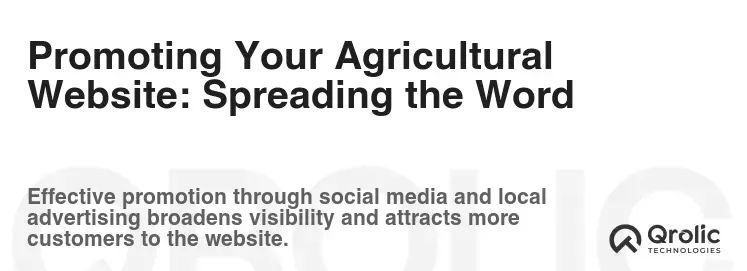
Once your website is live, you’ll need to promote it to attract visitors.
Social Media Marketing: Engaging Your Audience
Use social media to share your content, engage with your audience, and drive traffic to your website.
- Consistent Posting: Post regularly to keep your social media accounts active.
- Engaging Content: Share engaging content that is relevant to your audience.
- Social Media Advertising: Use social media advertising to reach a wider audience.
- Community Building: Build a community around your farm on social media.
Email Marketing: Nurturing Your Leads
Use email marketing to nurture your leads, promote your products, and share news about your farm.
- Segmentation: Segment your email list to send targeted messages.
- Personalization: Personalize your emails to make them more engaging.
- Automated Campaigns: Use automated email campaigns to nurture your leads and drive sales.
- Tracking and Analysis: Track your email marketing results to measure the effectiveness of your campaigns.
Online Advertising: Reaching a Targeted Audience
Use online advertising platforms like Google Ads and social media ads to reach a targeted audience.
- Keyword Targeting: Target your ads to users who are searching for relevant keywords.
- Demographic Targeting: Target your ads to users based on their demographics.
- Remarketing: Use remarketing to target users who have previously visited your website.
- A/B Testing: A/B test your ads to optimize their performance.
Public Relations: Building Your Brand Reputation
Use public relations to build your brand reputation and generate positive media coverage.
- Press Releases: Issue press releases to announce new products, events, or partnerships.
- Media Outreach: Reach out to journalists and bloggers to pitch your story.
- Community Involvement: Get involved in your local community to build relationships and generate positive publicity.
- Awards and Recognition: Apply for awards and recognition to showcase your farm’s achievements.
Content Marketing: Providing Value and Attracting Visitors
Create valuable and informative content that attracts visitors to your website and establishes your farm as a trusted source of information.
- Blog Posts: Write informative and engaging blog posts about agricultural topics.
- Infographics: Create visually appealing infographics that present complex information in an easy-to-understand format.
- E-books: Write e-books that provide in-depth information on specific agricultural topics.
- Videos: Create videos that showcase your farm, your products, or your farming practices.
Maintaining and Updating Your Website: Ensuring Long-Term Success

Creating a website is just the first step. To ensure long-term success, you need to maintain and update your website regularly.
Regularly Updating Content: Keeping Things Fresh
Keep your website fresh and engaging by regularly updating your content. This includes adding new blog posts, updating product information, and refreshing your website’s design.
- Content Calendar: Create a content calendar to plan your content updates.
- User Feedback: Solicit feedback from your users to identify areas for improvement.
- Industry Trends: Stay up-to-date on the latest industry trends and incorporate them into your content.
- Seasonal Updates: Update your website to reflect seasonal changes and events.
Monitoring Website Performance: Identifying and Addressing Issues
Use analytics tools to monitor your website’s performance and identify any issues that need to be addressed. This includes monitoring your website’s traffic, bounce rate, and conversion rates.
- Regularly Review Analytics: Review your website’s analytics regularly to identify trends and patterns.
- Identify and Fix Errors: Identify and fix any errors on your website, such as broken links and 404 errors.
- Optimize Website Speed: Optimize your website’s speed to improve user experience.
- Security Updates: Keep your website’s software and plugins up-to-date to protect against security vulnerabilities.
Backing Up Your Website: Protecting Your Data
Regularly back up your website to protect your data in case of a disaster. This includes backing up your website’s files, database, and images.
- Automated Backups: Use automated backup tools to schedule regular backups.
- Offsite Storage: Store your backups in a safe and secure offsite location.
- Test Restores: Regularly test your backups to ensure they can be restored successfully.
Staying Up-to-Date with Technology: Adapting to Change
Stay up-to-date with the latest web technologies and trends to ensure your website remains competitive. This includes keeping your website’s software and plugins up-to-date, implementing new features, and adapting to changes in search engine algorithms.
- Industry News: Follow industry news and blogs to stay informed about the latest trends.
- Experiment with New Technologies: Experiment with new web technologies to see how they can improve your website.
- Adapt to Algorithm Changes: Adapt to changes in search engine algorithms to maintain your website’s rankings.
Qrolic Technologies: Your Partner in Agricultural Website Success

Creating and maintaining a successful agricultural website can be a complex and time-consuming task. That’s where Qrolic Technologies comes in. We offer a comprehensive range of web design, development, and marketing services tailored specifically to the agricultural industry.
Web Design and Development: Creating a Custom Solution
We can design and develop a custom website that reflects your farm’s unique brand and meets your specific needs. Our team of experienced designers and developers will work closely with you to create a website that is visually appealing, user-friendly, and optimized for search engines.
- Custom Design: We create custom website designs that reflect your farm’s brand and values.
- Responsive Development: We develop mobile-responsive websites that adapt to different screen sizes.
- E-Commerce Integration: We integrate e-commerce functionality into your website to enable online sales.
- CMS Development: We develop websites using popular CMS platforms like WordPress.
Digital Marketing: Reaching Your Target Audience
We offer a comprehensive suite of digital marketing services to help you reach your target audience and drive traffic to your website. Our services include SEO, social media marketing, email marketing, and online advertising.
- SEO Optimization: We optimize your website for search engines to attract more organic traffic.
- Social Media Marketing: We manage your social media accounts to engage with your audience and drive traffic to your website.
- Email Marketing: We create and manage email marketing campaigns to nurture your leads and promote your products.
- Online Advertising: We manage your online advertising campaigns to reach a targeted audience.
Ongoing Support and Maintenance: Ensuring Long-Term Success
We provide ongoing support and maintenance to ensure your website remains secure, up-to-date, and performing at its best. Our services include website updates, security monitoring, and technical support.
- Website Updates: We keep your website’s software and plugins up-to-date.
- Security Monitoring: We monitor your website for security vulnerabilities.
- Technical Support: We provide technical support to address any issues that may arise.
Let Qrolic Technologies help you cultivate your online presence and grow your agricultural business. Visit us at https://qrolic.com/ to learn more.
Conclusion: Cultivating Your Online Presence for a Bountiful Future

Creating an agricultural website is a significant investment that can yield substantial returns. By following this comprehensive guide, you can create a website that attracts customers, builds trust, and ultimately helps you grow your agricultural business. Remember to focus on planning, design, functionality, SEO, promotion, and ongoing maintenance. With dedication and the right tools and partners, you can cultivate a thriving online presence and reap the rewards of a successful digital strategy. Don’t be afraid to seek expert help along the way. Your digital harvest awaits!
